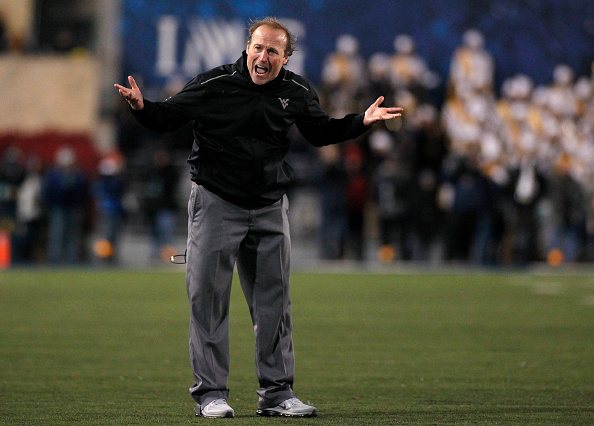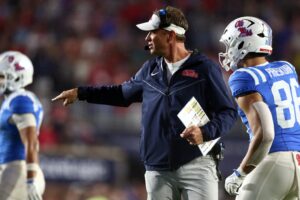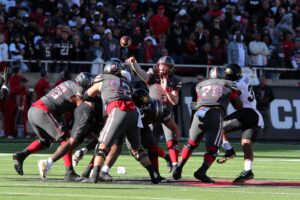Mountaineer Moments in Adversity Part Two
We began our Summer 2022 coverage of the West Virginia Mountaineers football team by covering Mountaineer Moments in Adversity. We started with part one last week. Now, we move on to part two. As we discussed in part one, we think the theme is important. Early predictions from “experts” see the Mountaineers having another tough season. We, however, are not as low as others on the 2022 version of WVU. Indeed, we think that Head Coach Neal Brown overcomes the adversity he and his squad have faced since his arrival in Morgantown. Fitting, then, that we take a look at one of the more recent Mountaineer Moments in Adversity in this part.
Moment Number Nine: WVU to the Big XII?
Beginning with the 2005 season, the West Virginia Mountaineers saw an unprecedented level of sustained success. Indeed, between 2005 and 2011, WVU amassed 70 wins. Only eight other power conference schools accumulated more wins during that time. Those schools include LSU (with 75 wins); Virginia Tech (74); USC (73); Florida, Oklahoma, and Ohio State (72); and Texas and Alabama (71). West Virginia and Oregon tied for ninth with 70 wins during that seven-year period.
Certainly, picking these seven seasons amounts to arbitrary sample size to most. For West Virginia fans, however, this matters. Their team undoubtedly played football like a top-ten team in the nation for seven full seasons. Unfortunately, the powers that be in college football pushed conference realignment, and that signaled the end of the Big East. With the conference’s demise looming, West Virginia scrambled to find a new home before it was “too late.”
Records show that West Virginia was promptly rejected for membership into the ACC, which would have been the most natural fit for the Mountaineers. The academic performance offered the “convenient” excuse, but we will likely never know the full story. The SEC showed some interest in the Mountaineers, but they decided to poach Missouri to pair with Texas A&M instead.
This left the Big XII as the only serious dance partner left for the Mountaineers, and West Virginia made the jump quickly, despite a late political push by Louisville to try and take the final spot in the Big XII.
Devil in the Details
On the one hand, West Virginia overcame adversity by pairing with the Big XII and ensuring it joined the realigned Power Five conferences into a high-major conference. That said, the move also threw more adversity at West Virginia.
First, West Virginia had been recruiting at a solid level for a Big East that averaged the 6th-toughest schedule among the twelve BCS conferences. That said, they were not built for the air raid offense dominating the Big XII at the time. This resulted in an unusual coaching decision by which Bill Stewart was asked to coach the Mountaineers with his replacement, Dana Holgorsen, learning on the job as offensive coordinator for a season. Infamously, Stewart spread rumors about Holgorsen to the Pittsburgh Post-Gazette which ultimately led to the early termination of Stewart as head coach. Now, the Mountaineers would be joining the Big XII with a Head Coach with exactly one year of experience and nobody to help teach him the culture of West Virginia.
Second, West Virginia would be required to travel more miles than virtually anyone else in Power Five football. Only the PAC-12 teams can compare (simply because of how much space the western-most conference spans). This would introduce a new element that the Mountaineers would have to tackle.
Third, the strength of schedule West Virginia dealt with increased significantly with a move for which they had very little time to prepare. Their strength of schedule averaged 1.41 in the final seven years in the Big East. After they moved to the Big XII, however, West Virginia’s strength of schedule more than doubled to 3.01. That is the difference between a top 50 strength of schedule to a top 25 SOS.
As a result, it should be clear that the move to the Big XII simultaneously represented the Mountaineers’ resiliency in adapting to conference realignment with a future intact and a whole new chapter in adversity with which WVU would have to deal.
An Ongoing Chapter in Adversity
At times during the Holgorsen era, it looked like the Mountaineers might turn the corner. Indeed, they started fast in Big XII play by jumping out to a 5-0 record with two wins over top 25 teams. They traveled to Lubbock ranked fifth in the country. Then, the miles racked up and reality set in as West Virginia lost five straight.
In 2016, however, West Virginia hit the 10-win mark again led by Skyler Howard and a veteran defense. With electric playmaker Will Grier waiting in the wings, fans thought the Mountaineers might have finally turned the corner. 2017 saw a regression, and 2018 had some great moments that ultimately led to a disappointing 8-4 finish.
Since joining the Big XII, West Virginia won 68 games in 10 seasons, a far cry from its 70 wins in their final 7 seasons in the Big East. The adversity, then, continues. Fans expect better, and they are not shy from voicing their opinions accordingly. Regardless, fans will learn a lot in the first three games of 2022 as the Mountaineers travel to face two of their oldest rivals in the first three games of the season.






